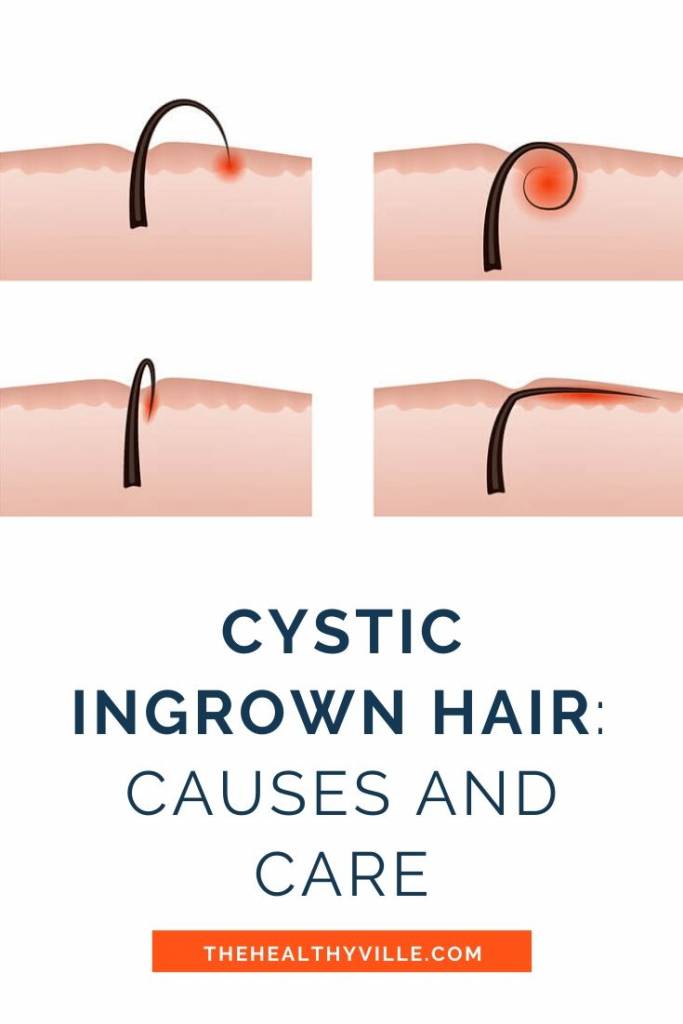The cystic ingrown hair appearance is annoying, unsightly and uncomfortable. Therefore, it is convenient to know some recommendations to avoid its appearance.
Cystic hairs are a frequent problem, which most people have ever suffered. They arise as a result of waxing or cream or razor shaving. It is the price that is sometimes paid for trying to keep the skin completely smooth and smooth.
The technical name of cystic hairs is “folliculitis.” They are also known as ingrown hairs and it is a condition in which hairs that fail to grow normally and are installed under the skin. Sometimes they get infected and, although they rarely have serious consequences, they are very annoying.
Usually, cystic hairs appear on the beard, chin or cheeks of men. In women they are more frequent in the armpits, legs and pubic area. The scalp is another area where they usually appear, both in men and women.
Cystic ingrown hair
Cystic ingrown hair are common in those who use waxing or shaving methods.
The hair originates inside the skin and traces a path that goes from the inside out. Thus, what is known as the hair follicle is formed, which is a kind of canal. It is born deep in the skin, just at the point where the cells that form the hair are.
In that path from the inside out there are also the sebaceous glands. These secrete a substance of fatty composition, whose function is to give smoothness and softness to the skin. Sometimes, the exit of the canal is clogged or damaged, and this prevents the hair from coming out.
Under these conditions, the hair begins to grow inward, below the skin. In this way the cystic hairs originate. They usually give rise to small lumps or papules, which when infected become pus. The skin shows a darker tone in that area and there is pain and itching.
Causes of the problem
The factors that most affect the formation of cystic hairs are the hair structure and the shape of the follicle. It is more common for a hair to become ingrown if it is curly and if the hair follicle has curvature. This setting causes the hair to re-enter the skin when it is cut.
It is also very common for hairs to become incarnate when skin is tense during hair removal or shaving. This tension leads to the hair retracting towards the skin, once it is cut. After this, it begins to grow inwards.
Hair removal with tweezers is also a frequent cause of cystic hairs. When pulling the hair it is easy for a part of it to be under the outer layer of the skin and continue to grow abnormally. This is more frequent when the hair has very tight curls.
Cystic hairs easily lead to infections, causing itching and scratching. It ends up infecting the area. They can also generate permanent scars or produce a change in the skin pigment.
Care and treatment
One of the recommendations for treating cystic hairs is to avoid shaving until the follicle heals.
The main measure of care against ingrown hairs is to avoid shaving or waxing until it does not heal. This takes between one and six months. If waiting is not possible, the best alternative is to have a laser treatment, as this allows hair to be extracted at a deeper level and also inhibits hair growth.
It is necessary to note that the laser treatment can cause undesirable effects such as blisters, darkening of the skin or scars. In case this type of treatment is not desired, it is also possible to address the problem with medications, usually in the form of cream.
To avoid the discomfort caused by cystic hair, it is best to keep the affected area very clean, washing it with water and a mild soap. It is also good to lightly rub the skin with a mane glove during the bath, and apply an antibiotic cream.
Read more: Calm the Skin Irritation from Shaving Using These 5 DIY Remedies!
Other info of interest
To prevent the formation of cystic hairs, the following measures are recommended:
- Do not shave or wax, but rather cut the hair with scissors or perform a laser hair removal.
- Use an electric shaver and do not cut your hair flush.
- If you choose to shave, you should use a blade with good edge.
- Apply foam to shave or wax.
- Do not stretch the skin before shaving.
- Shave in the direction of the hair.
- Apply extreme hygiene during hair removal.
- Exfoliate the skin frequently.
- Apply moisturizer after hair removal or shaving.
- Do not wear tight clothing.
Conclusion
Most of the time, cystic hairs are due to a benign problem. However, they do not stop being annoying and unsightly. In addition, if they are not treated properly, they can lead to an infection. Therefore, before any sign of complication, you should seek support from the doctor or dermatologist.
Don’t forget to SHARE the cystic ingrown hair causes and solutions with your friends and family on your social networks!

